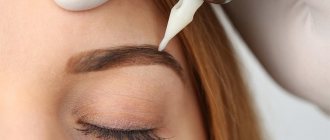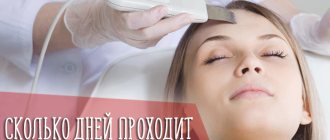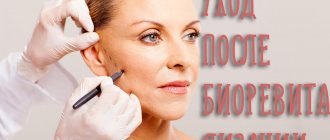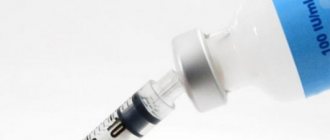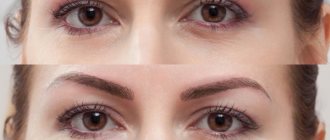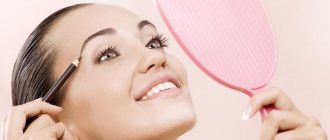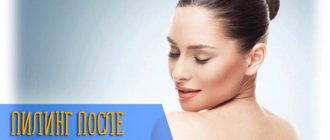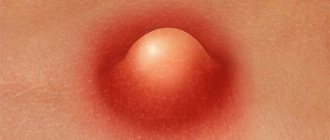Permanent makeup is an ideal option for women who do not have enough time to use decorative cosmetics on a daily basis. To avoid complications after the procedure, you should follow the rules regarding care during the recovery period. To avoid pathological problems, you should not wet your eyebrows after tattooing for the first few days.
Immediately after tattooing
Healing of the results obtained through permanent makeup can take up to one month. This type of exposure is called micropigmentation; dyes are injected into the subcutaneous layer with a special device with a needle at the tip. The achieved effect lasts from one to three years, but may begin to disappear earlier, under the influence of unfavorable factors. A woman can always visit a cosmetologist and carry out a correction to restore the lost brightness of the lines.
The introduction of dye into the subcutaneous layer leads to damage to the epidermis, so it takes some time for it to restore its own structure. Despite the differences in existing tattoo techniques, they are united by almost identical healing stages, which can take different times.
Immediately after the pigment injection procedure is completed, the brow ridges do not look too natural; they are very bright. Don’t be afraid of this; after 4-5 days, the process of lightening the pigment will begin, part of it will come out along with the separating ichor. That’s why the master applies a slightly larger amount than required, so as not to get an overly pale result. In addition, traumatic effects may cause tiny cuts and wounds to appear on the surface of the skin, from which blood may leak. This is an absolutely normal phenomenon and there is no need to be afraid of it.
How to wash your face without getting your eyebrows wet
Eyelash extensions or eyebrow tattooing are procedures during which you should strive to cleanse your face as delicately as possible. Touching the affected area is strictly prohibited. How to wash your face without damaging your makeup?
You can use some tips:
- cleanse the skin not completely, but in parts;
- use damp discs lightly moistened with water so that water does not drain from them;
- use as little water as possible;
- do not close the doors in the bathroom while washing, so that the moist air does not destroy the integrity of the crust;
- a ban on the use of terry towels; you can wipe yourself only with thin cotton fabrics, paper napkins, making blotting, but in no case rubbing movements;
- Change your body towel daily.
To take a shower and leave the permanent makeup area dry, it is very important to follow a number of rules:
- Maintain an optimal water temperature; hot water should be discarded; it will quickly fill the room with steam, which will adversely affect the condition of the crust. In addition, this opens the pores, which leads to increased swelling, redness, and increased pigment removal.
- When bathing in a shower stall, you should not lock the doors so that the steam that appears does not have a negative effect on your eyebrows.
- Wash quickly, no more than 5-10 minutes.
- Do not touch the neck, head, hair area.
Bathing in the bath is prohibited until the surface of the brow ridges has completely healed.
How long does healing take?
How many days the recovery period after permanent treatment will take can only be said approximately. Each person’s skin has its own characteristics; for some, the healing process is more active, for others it takes longer.
There are average periods that you can focus on. In addition, there are a number of recommendations that can shorten the healing process:
- give up alcoholic drinks during the recovery period, they will thin the blood, causing its secretion;
- In the first days, lymph will be released from the wounds; it should be blotted with a sterile dry cloth;
- after 4 days, the first crusts will appear, which are strictly forbidden to be removed with your own hands, they should fall off on their own (in about a week), if you do not adhere to this recommendation, the likelihood of infection, the development of an inflammatory process, the formation of scars, and gaps in pigment increases.
The recovery period differs from the tattoo technique:
- The classic one takes a long time to heal; here the master treats the entire brow ridge.
- Powder effect involves applying pigment in a dotted manner, which gives a shadow effect. The skin will heal slightly faster.
- The hair permanent lasts a little longer than the powder one, but faster than the classic one. The entire space is not filled here, only individual strokes are created.
- Shading involves creating blurry lines using a special attachment; this type heals a little faster than the classic one.
Pre-session activities
The speed of healing of the skin surface depends on the subtleties of eyebrow care. Don’t forget about preliminary preparation, which also has an important meaning.
General recommendations:
- it is better to choose a day for the procedure that does not fall during menstruation (at this time the pain threshold is lower, there is a possibility of active bleeding from the wounds);
- It’s better to go for a tattoo before the weekend so that swelling and redness don’t ruin your plans and interfere with going to work;
- give up antibacterial drugs, alcohol, energy drinks, blood thinners a week before the session;
- 7 days in advance, refuse to correct eyebrows with tweezers or other methods, so that the specialist examines the characteristics of hair growth and works with intact, undamaged skin;
- remove coffee from your diet in a couple of days, it reduces the pain threshold;
- The day before, you should not eat fatty, fried, or salty foods to reduce the likelihood of swelling.
Before going to the procedure, you should take a shower and wash your hair. Restrictions will be imposed on manipulations with water after tattooing. A couple of days before the procedure, an allergy test should be performed to determine the presence or absence of allergic reactions to the injected pigment.
First day care
Immediately after the procedure, two problems arise that should be addressed sequentially. The first is the release of the ichor; it is removed using a cotton pad or a sterile napkin.
Cauterization of wounds with aggressive alcohol compounds is prohibited.
The second problem is swelling of the skin, which is a reaction to damage to the integrity of the skin. When such a symptom appears, the use of antihistamines prescribed by a specialist is indicated.
You can use compresses from herbal decoctions (chamomile, calendula, sage, string). The main thing is to make sure that the wet cloth does not fall on the area of the brow ridges, but lies on the surface, next to them.
Why it is not advisable to get your eyebrow tattoo wet
Tattooing is a salon procedure that involves introducing a dye under the skin, which will give them a beautiful shape and rich color for a long time. It is considered safe because it is performed under sterile conditions. Pigment cannot be injected deeper than 1mm.
The integrity of the upper layer of the epidermis is compromised, which leads to swelling, irritation, and redness. This is a normal reaction of the skin to damage, but it is forbidden to wet the eyebrows.
Upon completion of the tattoo, the release of ichor from numerous microscopic wounds is observed. Over time, a crust forms. Do not tear off or wet the crust that protects the damaged skin of the eyebrows from infection. When water gets on the makeup site, it soaks it, causing the wound to open.
This is associated with the risk of consequences after the tattoo procedure:
- introduction of infection;
- worsening inflammation;
- delaying the skin healing process;
- distortion of the result.
You cannot wet an unhealed tattoo, soak it, or tear off the crust from it. It should fall off on its own a week after the eyebrow beauty procedure.
Stages of eyebrow healing
The stages of eyebrow healing include several days, over the course of which recommendations for caring for your own eyebrows change. The methods of the first day and after a week are slightly different.
The first day of tattooing: how to remove ichor and swelling
Immediately after tattooing, as noted above, the ichor that will appear on the surface of the eyebrows should be removed.
Do not be afraid of the excessive brightness of the pigment; after a few days it will return to normal.
The ichor (lymph) is released under the influence of the body’s protective reaction to damage. It is designed to protect the body from infection. Tattoo artists recommend wiping the surface of the eyebrows (without pressure) with a dry cotton pad at this time.
To reduce the likelihood of infection inside, use any antiseptic composition:
- Chlorhexidine;
- Miramistin.
It is recommended to carry out this effect up to 8 times a day, this will allow you to collect all the released liquid and reduce the thickness of the crust that will form afterwards.
To eliminate swelling and speed up the recovery process, wound healing compounds are used:
- Rescuer;
- Bepanten;
- D-Panthenol;
- oxolinic ointment;
- cosmetic Vaseline.
The selected product is applied with a cotton swab, after half an hour, the unabsorbed residues are carefully blotted with a clean napkin.
Second day darkening of eyebrows
Every day the eyebrow healing process will become more active. Already on the second day the swelling will be reduced and there will be no discomfort left. Now you can notice a strong darkening of the pigment, which is associated with the nightly release of ichor, which has dried up and formed a crust.
Currently, care includes the following activities:
- every 2 hours, wipe the affected area with an antiseptic solution;
- after drying, apply healing ointment;
- There is still a ban on washing with water.
To ensure that the body’s own regeneration process is more active, medications are not applied too often, trying to limit oneself to five procedures per day.
Already, a number of restrictions are imposed on a woman:
- exposure to frost, heat;
- visiting solariums, being in the open rays of the sun.
Third day, what to do with crusts
Now some people's skin is beginning to peel , which becomes a sign of activation of its protective reactions. The eyebrows actively become covered with crusts, under which itching may be felt. Getting rid of them is strictly prohibited.
Why can't you forcefully remove crusts?
- The likelihood of bleeding.
- Increased risks of infection entering the body, which will cause the development of a serious inflammatory process.
- Provocation of increased secretion of ichor, which will cause pigment leaching.
- Lengthening the processes of restoration of the brow ridges.
After the crusts cover the eyebrows, it’s time to wash your face. Now even delicate cleansers are allowed, as long as they do not contain abrasives or alcohol.
It is better to abstain from decorative cosmetics for now, and carry out the previous stages of treatment up to 5 times a day.
The period from the fourth to the seventh day after applying permanent makeup
During this period , insufficiently moistened crusts will begin to crack, and a strong feeling of itching may occur underneath them. Here you need to continue to use healing compounds, which will facilitate the slow separation of the plates from the surface of the skin.
If the itching is unbearable, you can lightly press with a clean cotton swab on the surface of the eyebrows.
During this period, antiseptics and ointments are applied no more than three times a day. By the sixth day, active removal of crusts begins; the main thing here is to restrain yourself and not try to speed up this process on your own. After the seventh day, the crusts will become thinner, the skin around may peel off greatly (this happens from prolonged exposure to an antiseptic).
Second week after tattooing color change
In the second week after permanent treatment, provided proper care is taken throughout this period, you can notice the first positive results.
- The crust is almost gone.
- Clear boundaries of the brow ridges appear.
- The eyebrow shade corresponds to the one chosen before the treatment.
Now a woman can use decorative cosmetics and face creams, trying to avoid their impact on the skin around the eyebrows. The antiseptic is applied in the mornings and evenings, and a healing cream is applied at the same frequency. Sleeping face down on a pillow is still not recommended.
Results one month after eyebrow tattoo
After actively using care products, a month later, the woman finds herself in the process of almost complete healing of the treated surface. Visually, the eyebrows will no longer change, although the restoration process itself is still ongoing inside.
Now deficiencies made by the master, or those that arose due to improper care, may become noticeable. Light gaps may appear in the eyebrows.
To correct the problems that have arisen, the woman goes to a specialist for correction. He will fill the gaps with pigment, correct the shape (if necessary), and may make changes to the eyebrow colors. If a woman is not completely satisfied with the result, she can resort to laser tattoo removal.
Is it possible to wet your face with water?
How long it takes until complete healing depends on the general condition of the body, existing immunity, and skin type. You will not be able to visit the pool, go to the bathhouse, sauna, or swim. You will have to abstain from water procedures for at least 5-10 days. You will also have to forget about hard terry or waffle towels.
You must follow the following instructions from the wizard:
- It is forbidden to touch the hairs with your hands for the first days; wiping them with a towel is not recommended. It is better to use soft moisturizing wipes marked “Alcohol-free, fragrance-free.” Baby wipes are ideal for this purpose.
- While the wounds are healing, you should avoid visiting the pool, bathhouse, and swimming in open water. The risk of accidental infection is too great. In addition, if it gets wet, the crust may fall off prematurely, removing some of the paint with it. This leads to uneven coloring and the appearance of lighter spots.
- Contact with water when washing is undesirable. It is recommended to wipe your face with a damp towel, avoiding treated areas. It is not recommended to use alcohol lotions, homemade masks or compresses for about 20 days.
- It is prohibited to apply creams, use decorative cosmetics, peeling, and scrubs. You can only use a special ointment recommended by a specialist. How long the ban will last depends on the restoration of the upper layers of the epidermis and the complete healing of the punctures.
- The use of hormonal ointments, alcohol solution, essential oils, and hydrogen peroxide for healing is strictly prohibited.
- It is forbidden to sunbathe while the color of the tattoo pigment is developing. This takes 2 to 3 weeks. At first it will be lighter than expected, then it will darken to the desired shade.
It is advisable to stop visiting the gym for a while, as increased sweating on the forehead can wet the scabs. The sun and ultraviolet rays of a solarium cause discoloration of the paint, this must be constantly remembered.
How to speed up the process
Every woman can make adjustments to the process of restoring her own eyebrows after tattooing if she follows simple rules.
- Mandatory treatment with an antiseptic solution (Chlorhexidine, Miramistin). This is necessary to prevent infection from penetrating the skin; treatment is carried out up to ten times a day, applying the product precisely.
- Use healing medications (Rescuer, Solcoseryl, D-Panthenol, Bepanten). They are needed to accelerate cellular regeneration.
- Wash your face in the correct way: during the first days this procedure is strictly prohibited, so as not to cause an infection or accidentally remove a crust. Afterwards, the use of a mild tonic, milk, but without alcohol is allowed. After the process, the face is dried with soft blotting movements of a clean towel.
- Using antihistamines to reduce swelling and inflammation.
- The use of moisturizing preparations, such as cosmetic Vaseline, will eliminate peeling and itching in the eyebrow area, which invariably occurs at the stage of scab removal.
How to avoid problems after the procedure
In order to avoid a problematic situation after the procedure, you should carefully follow all the advice and indications of the specialist. Before applying permanent makeup, you need to choose a time so that you can stay at home for several days. Staying at home will allow you to fully care for your eyebrows
At home, every girl will be able to carefully follow and follow all the instructions of the master, thereby avoiding many troubles. Another important factor is that the eyebrow area will not look aesthetically pleasing these days. Also, by staying at home for a couple of days, you can protect yourself from viral and infectious diseases.
When the skin is completely restored after tattooing, it will become sensitive and tender. For this reason, not only initial but also further care is important.
What not to do
In order for the recovery period to pass as quickly and comfortably as possible, it is not enough to completely follow the care recommendations of the cosmetologist. It is important to strictly follow his advice regarding everyday life.
A cosmetologist, after a tattoo, establishes the following prohibitions:
- touch the brow ridges with your hands, there is a risk of infection. All medications are applied only with clean cotton swabs;
- sunbathing in open sunlight or in a solarium, eyebrows may turn pale and the pigment will be unevenly distributed;
- visit a sauna, bathhouse, swimming pool, where there is high humidity, which increases the risk of contracting an infection and prolonging the recovery process;
- for the first three days, drink alcoholic beverages, which thin the blood and promote the release of pigment along with lymph;
- use peelings, scrubs, and other aggressive cosmetic products;
- Apply decorative cosmetics to the eyebrow area. Cosmetics can penetrate into open wounds, which will provoke the development of an allergic reaction;
- If an infectious process occurs, you should immediately seek treatment from a doctor, otherwise, pus will begin to be released, which will be a sign of bacteria entering the blood. This is dangerous not only for the appearance of the brow ridges, but also for the woman’s health.
Properly performed tattooing only gives half the result. The speed of healing of the skin, as well as the effect achieved, depends on how correctly a woman follows care measures during the recovery period.
The result of improper care
A negligent attitude towards the recovery process leads to negative consequences. Among the complications of eyebrow tattooing are the following:
- Uneven color distribution. This can happen due to peeling off crusts, fatty creams, ultraviolet radiation or allergies, or taking antibiotics.
- Color change. Also, if after the procedure you go to the sauna, pool, sunbathe, or use antibiotic cream, the shade may lighten.
- The beginning of inflammation. Accordingly, infection in the wound can be caused by poor hygiene or the use of dirty products.
- An allergic reaction can be either to the pigment or to the product eaten before or after the eyebrow tattoo procedure.
